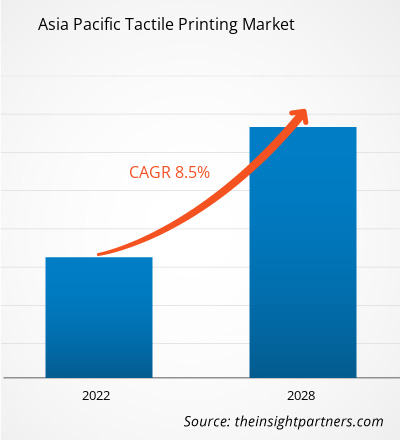The tactile printing market in APAC is expected to grow from US$ 476.33 million in 2021 to US$ 845.81 million by 2028; it is estimated to grow at a CAGR of 8.5% from 2021 to 2028.
Australia, China, India, Japan, and South Korea are major economies in APAC. Big efforts to promote tactile graphics adoption in developing countries is the major factor driving the APAC tactile printing market. The National Braille Press formed the Accessible Graphics Consortium (AGC), in 2021, to form a collaboration of a community of university researchers, teachers, and organizations engaged in offering common and standardized tactile graphics for visually impaired people. The aim of the consortium is to confer greater tactile graphic literacy through curriculum development, research, and improved production methods. It would analyze, collect advance, and disseminate best practices to the visually disabled community while focusing on recognized program for training tactile graphics in the stream of science, technology, engineering, arts, math (STEAM). The AGC would also form an Advisory Group to support these initiatives. The new consortium will work together to bring a unified approach for producing, teaching, and learning tactile graphics. Furthermore, developing countries lack the facilities and access to technology to assist the visually impaired community. Thus, increasing awareness about the advantages of tactile printing would boost the manufacturing of tactile printers to generate tactile graphics for various sectors. Such initiatives are likely to provide improved access through tactile graphics to the community of visually impaired people, thereby providing new opportunities for the growth of tactile printing market players.The APAC is characterized by the presence of many developing countries, improving economies, expanding industrial sector, and huge population. The high-paced urbanization and industrialization, coupled with high investments in industrial and commercial developments, in developing countries of the region is offering ample growth opportunities to the tactile printing market players. However, the ongoing COVID-19 pandemic is causing havoc in several countries in APAC. China is considered as a leader in the packaging industry, and the economy is likely to decrease up to 50% during and after the pandemic, as the companies with their packaging facilities in China have started shifting their businesses to India. Shutdown of various plants and factories in China is affecting the global supply chains and negatively impacting manufacturing, delivery schedules, and raw material sales. In India, most label printing companies are running at as low as 15–20% working capacity, while manufacturing companies are allowed to run at 50% capacity. Accommodation of workforces, alongside ensuring physical distancing, has been a challenge, and only small percentage of companies have been able to tackle it. In addition, due to sealed borders, the procurement of raw material such as ink, label stock, plates, and dies has become difficult. Schools and universities in the region are closed amid the second wave of COVID-19. This has affected the demand for tactile graphics and Braille printed study materials.
With the new features and technologies, vendors can attract new customers and expand their footprints in emerging markets. This factor is likely to drive the APAC tactile printing market. The APAC tactile printing market is expected to grow at a good CAGR during the forecast period.

- This FREE sample will include data analysis, ranging from market trends to estimates and forecasts.
APAC Tactile printing Market Segmentation
APAC Tactile printing Market – By Application
- Packaging & Labels
- Tactile graphics
- Secure Documentation
APAC Tactile printing Market – By End User
- Braille Users
- Industrial
- Government & Defense
APAC Tactile printing Market, by Country
- Australia
- China
- India
- Japan
- South Korea
- Rest of APAC
APAC Tactile printing Market - Companies Mentioned
- American Thermoform
- Canon Inc
- Index Braille
- Kanematsu USA
- Konica Minolta, Inc.
- Roland DG Corporation
- ViewPlus Technologies Inc
Asia Pacific Tactile Printing Report Scope
| Report Attribute | Details |
|---|---|
| Market size in 2021 | US$ 476.33 Million |
| Market Size by 2028 | US$ 845.81 Million |
| Global CAGR (2021 - 2028) | 8.5% |
| Historical Data | 2019-2020 |
| Forecast period | 2022-2028 |
| Segments Covered |
By Application
|
| Regions and Countries Covered | Asia-Pacific
|
| Market leaders and key company profiles |
- Historical Analysis (2 Years), Base Year, Forecast (7 Years) with CAGR
- PEST and SWOT Analysis
- Market Size Value / Volume - Global, Regional, Country
- Industry and Competitive Landscape
- Excel Dataset



Report Coverage
Revenue forecast, Company Analysis, Industry landscape, Growth factors, and Trends

Segment Covered
Application and End User

Regional Scope
North America, Europe, Asia Pacific, Middle East & Africa, South & Central America

Country Scope
Australia, China, Japan, South Korea
Trends and growth analysis reports related to Electronics and Semiconductor : READ MORE..
- American Thermoform
- Canon Inc
- Index Braille
- Kanematsu USA
- Konica Minolta, Inc.
- Roland DG Corporation
- ViewPlus Technologies Inc

 Get Free Sample For
Get Free Sample For